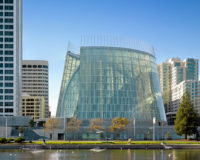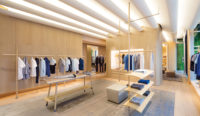Hong Kong, Kowloon
American architects are exporting a luxury product of a dimension and scale few clients in the United States can afford at home: the supertall skyscraper—that is, a skyscraper over 1,250 feet tall (page 160). Kohn Pedersen Fox (KPF), the architect for the 1,588-foot-high International Commerce Centre (ICC) in Hong Kong, opened in 2011, ventured into Asia in the 1990s, and soon made its mark with towers in Shanghai and Tokyo. By the time the firm completed the tallest building in China in 2008—the 1,614-foot-tall Shanghai World Financial Center—it was at the center of an inner circle of (mostly American) architects designing supertall skyscrapers. Now KPF's roster of higher-than-high-rises in the works include five in China—in Shenzhen, Chongqing, Guangzhou, Shenyang, and Suzhou—one in Seoul, and another in Doha, Qatar.
In 2000, KPF won the commission to design the 2.8 million-square-foot ICC that would loom up over the West Kowloon Station on the other side of Victoria Harbor from Hong Kong Island. The invited competition, which included Skidmore, Owings & Merrill (SOM), Pelli Clarke Pelli, and Kenzo Tange Associates, was initiated by developers Sun Hung Kai Properties, who had joined up with the Mass Transit Railway Corporation (MTR) to create an urban complex on 825 acres of reclaimed land. Residential high-rises, a W Hotel, restaurants, and cafés surround the signature tower planted atop a retail and mass-transit hub. In addition to spec office space, the ICC contains the super-luxe Ritz-Carlton Hotel within its upper reaches—for now the highest hotel in the world.
On the waterfront side of the tower to the east, construction of the Express Rail Link (ERL), a high-speed train to mainland China, is under way, and soon the much-touted West Kowloon Cultural District, planned by Foster + Partners as a series of low-rise museums and parks, will take shape to the south. Across the harbor rises the 1,335-foot-high Two International Finance Centre (2 IFC) in the Central District, also developed by Sun Hung Kai, and designed by Pelli Clarke Pelli in 2003. 2 IFC and ICC now form a totemic, monumental gateway to the city, each shooting up among an asparagus patch of Hong Kong's skyscrapers. If ICC's gleaming shaft lacks the instant recognition of Foster's much shorter HSBC (1986), its quiet comportment serves as a welcome antidote to the hurly-burly of most Hong Kong high-rises. Overlapping glass panels articulate the tapering elongated shaft, which terminates at the ground in a curved glass shed over the atrium. ICC's glass shingles and scooping canopy allude obliquely to the scales and tail of a dragon. “ 'Kowloon' means 'nine dragons,' ” says Pedersen of the place name that refers to the dragonlike form of Hong Kong's hills.
You arrive at the ICC by metro from the airport or Hong Kong Island—or by car on a curving road that leads to the hotel and office lobbies atop the station roof. From the car drop-off at Level 9, local and express elevators with requisite sky lobbies shoot up the tower: One stop away is the Ritz-Carlton reception area on the 103rd floor, where double-height restaurants overlook the city. On the uppermost (118th) floor you find the gym and pool, plus the over-the-top pulsating Ozone bar. It's all about the view, which sometimes the interior designers of the restaurants (Tokyo-based SPIN Design Studio) and the bar (the Japanese firm Wonderwall) forget in drowning the spaces in cocktail concoctions of splashy colors and frenetic motifs. LTW Design Works of Singapore gave the guest rooms a rich Buddhist-boudoir look.
The ICC tower relies on a reinforced-concrete central core and an eight-mega-column structure for its square-donut plan, proposed by the structural engineer for the conceptual design, Leslie E. Robertson. Outrigger trusses couple the central core to the mega-columns on four different floors in the tower, with the lowest one made of prestressed concrete and the others constructed of structural steel. To deal with the soil and, below that, a clifflike bedrock, structural engineers for the execution of ICC, ARUP, turned to shaft-grouted friction barrettes for the foundation. As ARUP director Philip Lai explains, the barrettes—rectangular concrete piles, with an average depth of 230 feet—transfer loads on four sides to adjacent soil for stability (for more details see architecturalrecord.com).
Since the major problem confronting supertall towers is wind loads, Pedersen designed a reentrant (notched) corner to mitigate vortex shedding. Overlapping glass panels, each one-story high, spill down the facade, articulating the skin and creating canopies for the offices and hotel entrances. The flat, shingled panels lift up horizontally 5 degrees from the sloping wall; at the base, where the tower meets the atrium, the panels seem to slide into a catenary curve formed by three tangential arc segments.
The silver-coated, low-E glass shingles come in two types— one, a 10-foot-wide-by-5-foot-high glass-spandrel panel covering the slab edge and perimeter beam; the other, a 5-foot-wide and 10-foot-high vision panel. (At the reentrant corners, a striped, ceramic-frit spandrel panel helps cut glare.) The high-performance glass—and a system of sensors and monitors for HVAC use, which was developed with Hong Kong Polytechnic University—should reduce energy consumption by 15 percent, compared with an average office building.
Clearly, the cost of the supertall is not cheap. According to the architects, ICC's total budget was not made known even to the team. Katz maintains that the developers supervised costs and construction time quite closely on a need-to-know basis as the different parts of the building went out to bid.
Now, a year after this vast, vertical city opened, it is possible to stay in the Ritz-Carlton, do business with financial firms, such as Credit Suisse, Morgan Stanley, and Deutsche Bank ensconced below, shop in the mall, and take the metro to 2 IFC, where you can repeat this experience—without going outside. Soon you will be able to go directly from the ICC to Shenzhen or Guanzhou. Most of the time you'll occupy American export architecture, a fitting ambience for a monocultural luxury retail environment dominated by Armani, Chanel, and the like. It's almost like being in New York, but unlike Manhattan, it's a lot taller, denser, and harder to go outside and just take a walk around the block.
People
Architect: Owner: Sun Hung Kai Properties
William Pedersen FAIA FAAR, Design Principal Associate architect: Wong & Ouyang Interior designer(s): KPF (Office Public Areas), LTW Design Works (Hotel)
Engineer(s):
Consultant(s): General contractor: Sanfield Renderer(s): AMD, Superview (3) CAD system, project management, or other software used: Autocad, Rhino3D Gross square footage: 2,822,136 Completion date: May 2011 |
Products
Exterior cladding
Glazing
Doors Special interior finishes unique to this project: Specialty stone interior supply and fabrication: Mariotti Carlo & Figli, contact Primo Mariotti at primo@mariotticarlo.com |






























Post a comment to this article
Report Abusive Comment